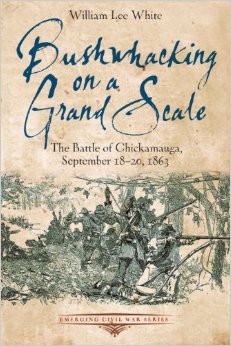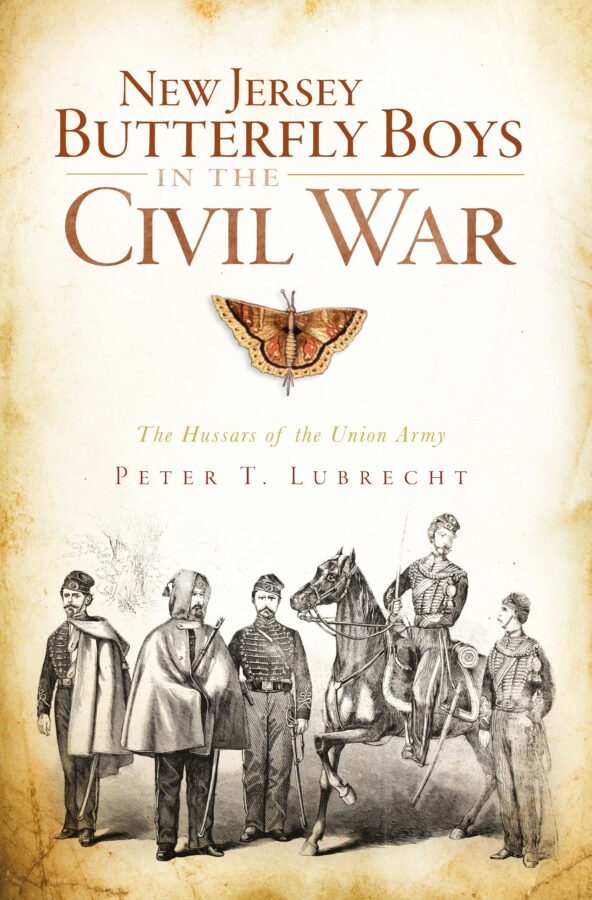Bushwhacking on a Grand Scale: The Battle of Chickamauga, September 18-20, 1863 by William Lee White. Savas Beatie, 2013. Paper, IBSN: 978-1611211580. $12.95
 The Battle of Chickamauga ranks as the second bloodiest engagement of the Civil War. It also stands as the only major victory by Confederate arms in the western theater during the conflict. Fought over the course of three days, it was a complex and confusing struggle amid woods and farmers’ fields along the Chickamauga Creek in north Georgia.
The Battle of Chickamauga ranks as the second bloodiest engagement of the Civil War. It also stands as the only major victory by Confederate arms in the western theater during the conflict. Fought over the course of three days, it was a complex and confusing struggle amid woods and farmers’ fields along the Chickamauga Creek in north Georgia.
The battle resulted from operations directed upon the possession of the strategic city of Chattanooga, Tennessee. General Braxton Bragg’s Confederate Army of Tennessee had occupied the Tennessee River city since July 1863, having been forced out of Middle Tennessee in the so-called Tullahoma campaign. Rebel occupation of Chattanooga barred the way into Georgia by Union forces.
The Tullahoma campaign had been a nearly bloodless victory for Major General William Starke Rosecrans and his Union Army of the Cumberland. Rosecrans, however, remained rather inactive for weeks before finally advancing south toward Bragg’s army in late August. As he had done earlier, Rosecrans used skillful maneuvers to outflank Bragg’s position, forcing the Confederates to abandon Chattanooga. The federals entered the city on September 9 as their foes retreated into north Georgia.
With units arriving from the Army of Northern Virginia, Bragg assumed the offensive against the pursuing federals. The rebels struck initially on September 18, attacking the Union left flank and securing crossings of Chickamauga Creek. The combat escalated the next day as Confederate assaults pressed against Rosecrans’s entire line. The wooded terrain hampered Southern coordination, and troops on both sides stumbled into unexpected clashes.
A rising fury engulfed the battlefield on September 20. About noon, Rosecrans ordered Brigadier General Thomas Wood’s division to the support of another unit. The withdrawal of Wood’s brigades created a gap in the Union line, and toward it surged Major General John Bell Hood’s veteran troops from the Army of Northern Virginia. The breakthrough unraveled the federal ranks, with shattered brigades streaming to the rear. Hood, however, suffered a serious wound, which caused a delay in the Confederate pursuit.
Meanwhile, on Horseshoe Ridge, Major General George H. Thomas fashioned a defensive stand with troops from his Fourteenth Corps. On came the rebels in a series of attacks, but Thomas’s veterans repulsed the assaults—arguably saving Rosecrans’s army from possible destruction. During the night of September 20-21, the Federals retreated to Chattanooga, trailed by the victorious Confederates. A two-month siege of the river city followed. The Battle of Chickamauga had exacted more than 34,000 casualties.
The title of this volume is taken from Union Brigadier General John Turchin’s description of Chickamauga. A veteran of the battle recounted that he had never been in an engagement in which the opponents fought so often while lying down. Unquestionably, the woods and open fields shaped the nature of the combat and worsened the slaughter.
This book is a tour guide to Chickamauga. The author is a National Park Service ranger at the Chickamauga and Chattanooga National Military Park, and his familiarity with details of the battle and the terrain is evident throughout the tour. In fact, he was born on a section of the battlefield. The tour consists of fifteen stops. At each, the author provides a detailed description of the action there. His accounts, however, may prove too daunting for the average tourist, and will challenge the understanding of a serious Civil War buff. The best and most useful tour guides provide orientation at each stop, which this book does not do. The descriptions of the fighting at each stop are well done, but perhaps too much for a tour of an extensive battlefield.
Appendices examine the movement of James Longstreet’s two infantry divisions and an artillery battalion from Virginia to Georgia, civilians at Chickamauga, the battle in memory, and provide an order of battle for each army. A list of books on the engagement is provided, but surprisingly, it does not include Peter Cozzens’s This Terrible Sound, the fullest treatment of the Chickamauga campaign.
This tour guide offers much in its descriptions of the battle. The book is amply illustrated and mapped. The lack of an orientation and the lengthy accounts of the combat at each stop, however, will challenge the most informed visitor.
Jeffry D. Wert is the author of numerous books, including A Glorious Army (2011).
